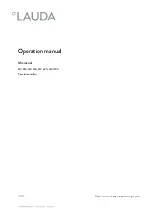
Figure 1
●
Warmup
- In cold weather, always allow the engine five or 10
minutes to warmup before plowing (See the Horse Tiller
Operator’s Manual for starting and operating instructions.).
Running the engine before use heats the oil so that it flows
for proper engine lubrication. While warming up the engine,
leave the Wheel Speed Shift Lever in Free Wheeling position
and put the Forward/Reverse Lever in Forward position for
five minutes or more. This rotates the tine shaft and warms
the transmission gear oil. Before doing this, make sure that
the tines have been removed and that the Depth Regulator
Lever is pushed all the way down to the travel setting (top
notch engaged on lever). Later, when removing snow, pull
the drag bar all the way up to allow you to raise the blade as
high as possible for banking.
●
Plowing Deep Snow
- It is best to remove a top layer several
inches thick in the first passes before attempting to remove
all the snow. Start near the end of the drive and gradually
work back up.
●
Plowing Light Snow
- Make the first pass in the center of the
area being plowed, with the blade angled right (A, Figure 9).
The blade can remain in this position, until the last pass,
when the blade is angled away from the center for this portion
of the plowing operation. When you reach the end of the last
pass down the center, begin to follow the pattern for light
snow (A).
●
Wheel Speed When Banking Snow
- Use the Slow Wheel
Speed and High Belt Range, throttle back the engine about 25
percent when banking snow. The slower throttle speed
enables better control and protect the wheel shaft and gears
from damage if the tiller should strike a hidden immovable
object.
NOTE: When using the High Speed Belt Range and Fast Wheel
Speed, throttle back the engine to approximately 70%.
IMPORTANT:
Throttling back is very important! The resulting
slow down prevents too much build-up of momentum. If the
blade strikes an immovable object , the resulting shock could
damage the wheel shaft or transmission gears.
Dirt Dozing Tips
Your Dozer/Snow Blade is also handy during spring, summer
and fall for various dirt moving jobs. You can fill ditches,
spread mulch and manure over the garden, do light grading,
prepare land for a small swimming pool to name a few applica-
tions. Again, you’ll get the most work from your Blade if you
use these hints... then carefully experiment.
●
Hard Packed Soil
- The Blade should be used for moving
loose dirt... it can’t dig into unbroken soil or hard-packed
piles like a bulldozer. Thoroughly loosen the soil with the
tines (before you take them off for safety) or use hand tools
to break-up hard-packed piles.
●
Soil Condition
- The soil (or mulch, or manure) is best
moved when it’s dry. If it’s very wet, it can stick to the blade,
and the moisture’s extra weight means you’ll move less per
pass. Also, when the material is nearly dry, you can spread
the material more evenly–it doesn’t clump up.
●
Dozing Dirt Piles
- Avoid trying to take too big a bite from a
pile at once Angle the blade away from the pile and start at
one side. Then, spread the load evenly, with the blade
straight ahead. In this manner, when you “cut away” at a pile,
the pile breaks itself up for you.
IMPORTANT:
Check engine oil level frequently during snow-
plowing or earth dozing.
For customer assistance, visit www.troybilt.com, contact your nearest authorized dealer or:
TROY-BILT LLC, P.O. BOX 361131, CLEVELAND, OHIO 44136-0019, 1-866-840-6483
Printed in U.S.A.
Form 769-00134 (03/2002)






















